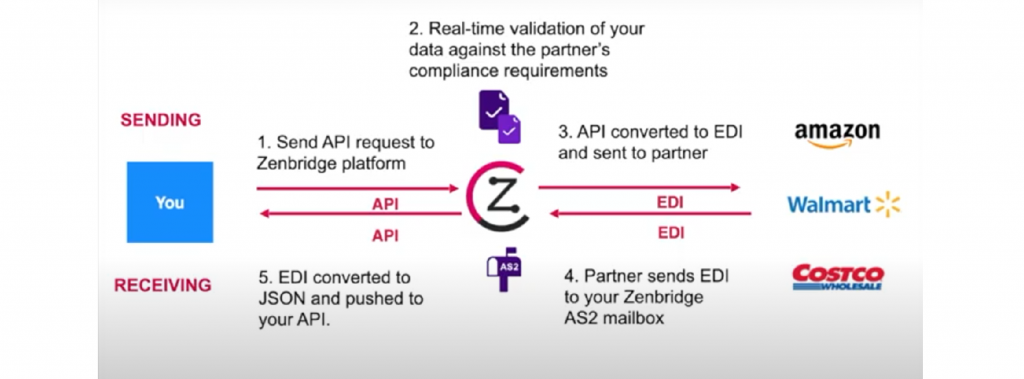
Converting EDI to API and API to EDI
On January 8, 2021 by Karthikeyan Mani KannanImportance of EDI in Retail
While the challenges involved in running an efficient supply chain have increased rapidly, the toolsets for EDI integrations have remained largely stagnant. They are old and clunky. The market is also plagued by legacy service providers who are very slow. Most of them don’t have an API to get access to your EDI data, which makes matters even more difficult. EDI via API is an inevitable solution in the modern retail industry, helping brands, manufacturers and distributors connect electronically with suppliers and vendors. The retail industry is faced with processing humongous orders every day and paperless transactions through EDI via API equip them with automated order processing and inventory management.
Especially in the retail industry, customer expectations demand speed, accuracy, transparency and omnichannel presence. Given this reality, whether it’s your ERP or WMS, the ability to connect these systems and extract intelligence and information has become an absolute necessity. Most modern-day enterprise systems have APIs that let you interact with them. It allows organisations to be more automated, transparent and proactive.
While EDI integration is an important aspect of doing business in the Retail industry (Read: Best EDI Practices for Retail), it is still out of reach for API developers. They are the biggest developer population across the globe. However, there is no API-centric development toolset that makes EDI accessible for this massive, commonly found talent pool. Most organizations would find it easy to hire an API developer as opposed to hiring an EDI developer.
EDI integration cannot be carried out the legacy way anymore. It has to be complemented by API (Checkout our Forbes article & our Whitepaper on EDI vs API). And Zenbridge does exactly that. We are a platform for API developers to carry out EDI integrations without understanding EDIs or setting up EDI infrastructure.
Zenbridge: EDI to API platform
Zenbridge is a cloud platform to send and receive EDI via API. You can basically convert the API to EDI and vice-versa. Our API eliminates the time and cost spent on building EDI expertise and infrastructure. API development is one of the most commonly found skill sets among today’s developers.

Our platform reduces all the complexities of EDI specifications and compliances down to easy-to-use APIs. As of now, Zenbridge supports JSON format for data payloads in the API calls.
Converting EDI to API & Vice-versa (How it works)
When it comes to EDI integration, each trading partner has its EDI requirements and specifications. For example, Amazon would want you to send the Amazon reference number while sending the Shipment notification EDI (ASN/856) back to them.
Zenbridge exposes EDI specifications of all major US retailers and supermarkets as API end-points, allowing seamless EDI via API integrations. The request and response structures are available as a Swagger API documentation and console.
Though Zenbridge comes preloaded with API for EDI integrations with all US retailers and supermarkets, you can set up any of your trading partners on our platform. Just configuring their EDI specification on the platform will turn that into API.
API to EDI (Sending EDI to partners)
To send an EDI to your partner, you need to make an API call to the Zenbridge platform. The platform’s API will take your JSON data, and validate it against your partner’s compliance requirements. If the data is compliant, you will get an HTTP 200 response back. The platform would then generate the EDI according to your partner’s EDI specifications and will send it to their AS2 or sFTP or any other connection type they might have.
In case of your data is non-compliant, the API will send back an HTTP 400 error to your API client with the error messages. This real-time validation ensures you never send non-compliant EDI to your trading partner and eliminates non-compliances fees for your organization.
The API request & response structure for a retailer’s/partner’s EDI document is available as API documentation on the platform. Here is an example.
EDI via API (Receiving EDI from partners)
When you sign up with Zenbridge, an AS2 mailbox is automatically created for you. Your partners should then use this AS2 connection to send EDI files to you.
As the second step, you can set up Webhook/Callback URLs on the platform. When your partners send EDI to you, it would be converted to JSON and pushed to the Callback URL you set up on the platform.
The received EDI transactions from your partners can also be viewed in Zenbridge’s Dashboard. The transaction view displays the EDI in a neatly formatted view that is familiar to your operations team. For example, a Purchase order would look like how it would in most ERPs used today. There are views to view the raw EDI content and also the converted JSON.
API for partners that are not on Zenbridge
Zenbrige platform comes preloaded with APIs for EDI of all major US retailers and supermarkets. However, you might have partners such as your 3PL or transportation company that are not on the platform.
The good news is that using Zenbridge, you can convert any EDI specification into API by configuring the EDI specification in the platform’s admin panel. If you are not familiar with EDI specifications, our experts will help you set them up. Any EDI specification that is on Zenbridge is automatically exposed as an API. That’s our magic.
EDI Standards supported by Zenbridge
Zenbridge is the only platform in the market that can convert all EDI documents across all versions of ANSI X12 and EDIFACT into API. This means that your company is ready to trade with partners across the globe and across different industries using EDI via API.
More questions?
If you have more questions, please don’t hesitate to book a demo session with us. We would love to show you our platform.
Happy Integrations!

Leave a Reply